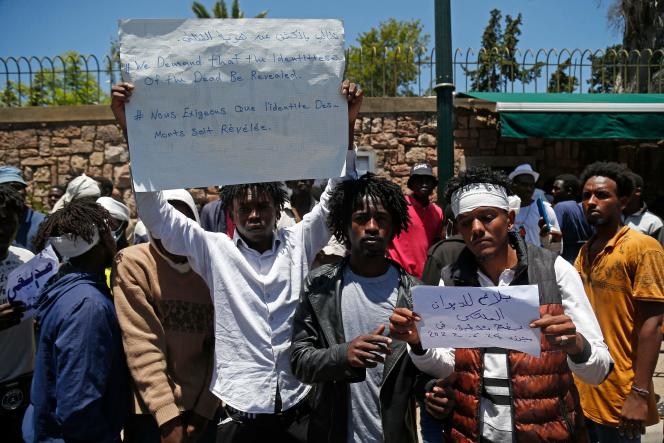The emotion remains strong and the controversies multiply a few days after the tragedy which occurred on Friday June 24 at the entrance to Melilla, Spanish possession in the north of Morocco, where at least twenty-seven sub-Saharan migrants, according to an unofficial report, perished during an attempt to force a passage inside the enclave.
The UN called on Tuesday, June 28, for an “effective and independent investigation” and denounced “excessive use of force” against migrants “on both sides of the border”. The UN Security Council was due to meet on Wednesday on the subject. For his part, the chairman of the commission of the African Union (AU), the Chadian Moussa Faki Mahamat, expressing his “deep emotion at the violent and degrading treatment of African migrants seeking to cross an international border between Morocco and Spain,” pleaded for “an immediate investigation.” The Spanish Public Prosecutor’s Office also announced that it had requested the opening of an investigation, given “the seriousness of the facts that have occurred, which could affect human rights and the fundamental rights of individuals”.
No new human toll has been communicated by the Moroccan authorities since that of Saturday, which reported twenty-three dead migrants and one hundred and forty Moroccan police officers injured during clashes near the fenced border separating Melilla from the city of Nador. . For its part, the Moroccan Association for Human Rights (AMDH) lists twenty-seven victims.
Fear of burials without identification or autopsy
Five days after the tragedy, the associations fear that the bodies will be buried without identification or autopsy, while around twenty graves have been dug in Nador by the authorities since Sunday, according to them. “The argument put forward by the authorities is that the hospital does not have enough space to keep the bodies in the fridges, indignantly an official of the Collective of sub-Saharan communities in Morocco, who wishes to remain anonymous. The problem is that no action has yet been taken on the victims, he laments. We do not know their identity and we do not know what they died of. »
According to the Nador branch of the AMDH, sixty-five migrants who participated in the attempt to cross the border are being prosecuted. Thirty-six of them, charged with “illegal entry into Moroccan soil”, “violence against law enforcement officers” or “armed mob”, will be tried on July 4 before the court of first instance of Nador, according to the AMDH. The other twenty-nine will be tried from July 13 by the Court of Appeal for more serious charges, in particular that of “participation in a criminal gang with a view to organizing and facilitating illegal immigration abroad”, still according to the association, which was able to establish that the majority of the migrants prosecuted were from Sudan. “They come from Darfur, but also from Kordofan, two regions which are the scene of conflicts, underlines a source who requested anonymity within the AMDH. For us, they are refugees. »
The presence of Sudanese in Morocco had hitherto received little attention. In their attempts to cross into Europe, they had favored the migratory routes transiting through Libya, known as the “Central Mediterranean”. However, it seems that the increasing difficulties linked to their crossing of Libyan territory led them to take the road to the West, in this case to Morocco. “In Libya, the Sudanese are targeted by traffickers practicing extortion, because they pay higher ransoms than other Sahelians,” notes Raouf Farrah, researcher at the organization Global Initiative Against Transnational Organized Crime (GI- TOC), based in Switzerland. It is now cheaper for them to take the western route, even though the loop is longer. They were helped in their business by Sudanese intermediaries in Nador. »
Algiers questioned by Rabat
This itinerary, however, is part of a completely different issue, that of the tensions between Morocco and its neighbor, Algeria, which have entered an acute crisis in their relations since the summer of 2021. A press release from the embassy of the Cherifian kingdom in Madrid on Tuesday blamed Algiers for the arrival of Sudanese migrants. “The attackers entered through the border with Algeria, taking advantage of the country’s deliberate laxity in controlling its borders with Morocco,” the statement said. Algeria replied through the voice of Amar Belani, special envoy in charge of Western Sahara and the Maghreb countries. “Lacking the courage to take responsibility for their own turpitude, the authorities of this country are constantly looking for scapegoats to shirk their responsibilities,” he told the Algerian news site TSA.
Since Friday, hundreds of migrants – nearly a thousand, according to associations – have been turned back by bus inside Morocco. Others fled or hid in the forest of Nador. This area already housed refuges for migrants who were under increasing police pressure in the cities of the region, Oujda or Nador, before the tragedy broke out. “There have been several dismantling of their camps, and clashes with the police have been reported,” says Nadia Khrouz, political scientist at Mohammed V University in Rabat-Agdal. There have also been arrests and sanctions for illegal stay. Adding to this prior tension, “the assistance that could have been provided by associations providing tents, blankets and food has been reduced in recent months”, she adds.
A sit-in is planned for Friday, July 1, in front of the Parliament in Rabat, at the call of several human rights associations, to demand “the opening of a national and international investigation in order to shed all light, independently, on these events, those responsible for and the consequences of migration policies financed by the European Union and implemented by the States”. A hundred associations – European and African – signed the declaration entitled “The Spain-Morocco agreement on immigration kills”, published the day after the tragedy. On Monday, the National Human Rights Council, an official Moroccan body, announced the creation of a fact-finding mission to “obtain cross-cutting information” on this “tragic” event.
Mopping operation
While the images of dozens of bodies, dead or injured, piled up and lying on the ground, without any help, went around the world arousing indignation, the Moroccan authorities released their own images on Monday. According to the Moroccan press, these would have been presented, Sunday, to African ambassadors in Morocco, during a meeting at the Ministry of Foreign Affairs in Rabat. They show that the clashes began on Thursday during a search operation launched by the authorities, who would have heard of the attempted forced passage that was being prepared.
Videos also show a group of several hundred people surging through the streets of Nador on Friday morning, then part of the fence collapsing under the weight of migrants. According to Moroccan authorities, the victims were killed “in jostling and falling from the iron fence” during “an assault marked by the use of very violent methods by the migrants”. During the meeting on Sunday in Rabat, the Director of Migration and Border Surveillance at the Ministry of the Interior, Khalid Zerouali, denounced “the criminal actions of trafficking networks”, accusing them of planning attacks “of quasi-military way”.














